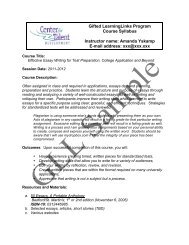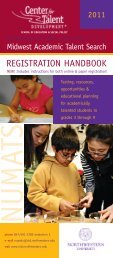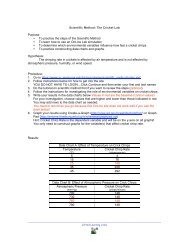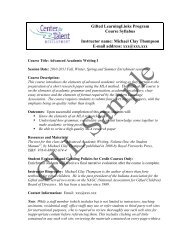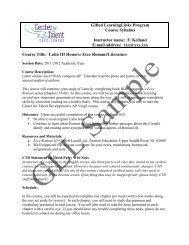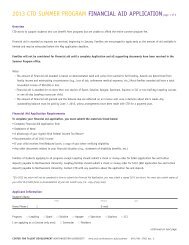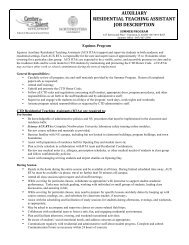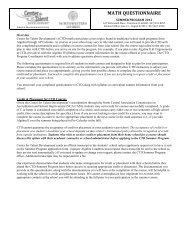2012 Summer Program - Center for Talent Development ...
2012 Summer Program - Center for Talent Development ...
2012 Summer Program - Center for Talent Development ...
- No tags were found...
You also want an ePaper? Increase the reach of your titles
YUMPU automatically turns print PDFs into web optimized ePapers that Google loves.
are challenged to use these concepts aswell as cultural, economic, organizationaland environmental concerns as theydevelop their own drawings and structuresand “build” cities of the present andfuture.Note: Additional $120 materials feerequired.Offered: Session 142. Designing Machines That Work:Engineering & PhysicsHow do machines work? How do youbuild the strongest bridge with the lightestbuilding material? In this active classroomenvironment, students learn about thefundamentals of physics as they investigateengineering concepts such as the conservationof energy, Newton’s law of gravity,and the theory of motion. They test thesetheories — and their own ingenuity — bygenerating creative alternatives to practicalproblems faced in scientific and technologicalfields today. To complement the labwork, field trips and presentations serve ascatalysts <strong>for</strong> new ideas.Note: Additional $120 materials feerequired.Offered: Sessions 1 & 243. Up, Up & Away: The Science ofAerodynamics & FlightThe mysteries of flight have intriguedhuman beings <strong>for</strong> centuries. Like theWright brothers and Charles Renard, studentsstudy the principles that underlieaerodynamics — motion, <strong>for</strong>ce, energy,density, and the work of Galileo, Newton,and Bernoulli — and apply these conceptsdaily in lab and project work. Students followthe historical development of flyingmachines by constructing their own kites,parachutes, hot air balloons, gliders, helicopters,planes and rockets. This courseintroduces students to the concepts ofphysics and aeronautical engineering.Note: Additional $120 materials feerequired.Offered: Sessions 1 & 2Engineering students build the most aerodynamiccar!44. Astronomy & Astrophysics:Beyond the Milky WayExplore the properties of stars, blackholes, galaxies, and more; learn about thecontinuous expansion of the universe; andconsider the possibility of extraterrestriallife! Students learn basic physics and mathematicalconcepts while studying topicssuch as stellar evolution and classification,solar physics and relativity. Studentsresearch planets, galaxies and contemporarytheories about life and communicationin the cosmos while learning aboutthe tools and methods used to collect datain space.Offered: Session 245. Detective Science: An Introduction toForensics“Eliminate all other possible solutions tothe crime and there’s only one left; it mustbe the answer, no matter how absurd.”This was a guiding philosophy of SherlockHolmes and still is <strong>for</strong> the detectives ofpopular TV dramas. In this course, studentslearn the <strong>for</strong>ensic science involved insolving crimes, including how to collectfingerprints, crack secret codes, and examinecorrosion evidence. Earth sciences,technology, life sciences, and physical sciencesare combined to solve new mysteriesevery day. The course also includes studyingdetective fiction, from writers BlueBalliett and Ellen Raskin.Note: Additional $120 materials feerequired.Offered: Sessions 1 & 246. ZoologyLions and tigers and bears, oh my! Theanimal kingdom is vast and often mysterious.Participants learn the basics of animalbiology related to structure and physiology.Students investigate evolutionarymechanisms that lead to the diversity ofvertebrate and invertebrate animals. Whileconducting hands-on and virtual dissectionsand fieldwork, students identify,compare, and contrast the critical featuresused to classify animals into major groups.Note: Additional $120 lab & materials feerequired.Offered: Session 147. Breakout Biology: Infectious DiseaseInfectious diseases have plagued and puzzledhumanity from the beginning of time.From the common cold to West Nilevirus, infectious diseases continue to roamour planet. Students learn about the fieldsof microbiology, immunology and epidemiologyas they are introduced to themicrobes that cause diseases, such as bacteria,viruses, parasites, fungi and prions.They also investigate host-agent-environmentalrelationships and disease causationin an ef<strong>for</strong>t to understand how peoplemanage and prevent disease. Studentsstudy how the human immune systemworks to keep us healthy. They look atadvances in medical technology that havehelped combat disease, have eliminatedsome, and allow us to continue to findcures <strong>for</strong> others. Students learn to questionand hypothesize, identify and manipulatevariables, observe, measure andrecord data, and analyze and interpretresults.Note: Additional $120 lab & materials feerequired.Offered: Session 2847/491-3782 www.ctd.northwestern.edu NORTHWESTERN UNIVERSITY CENTER FOR TALENT DEVELOPMENT 27





